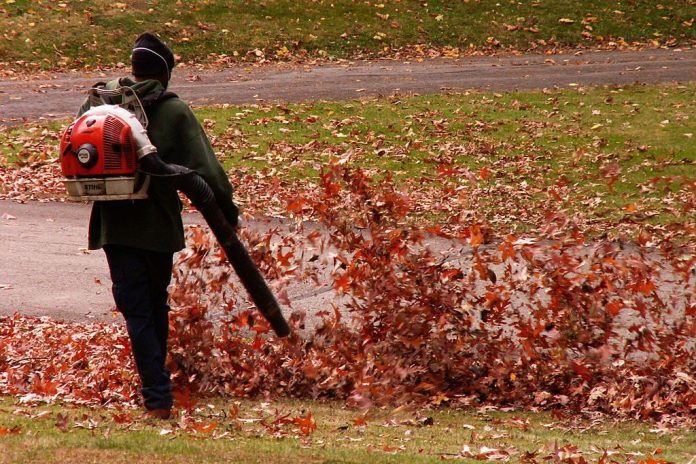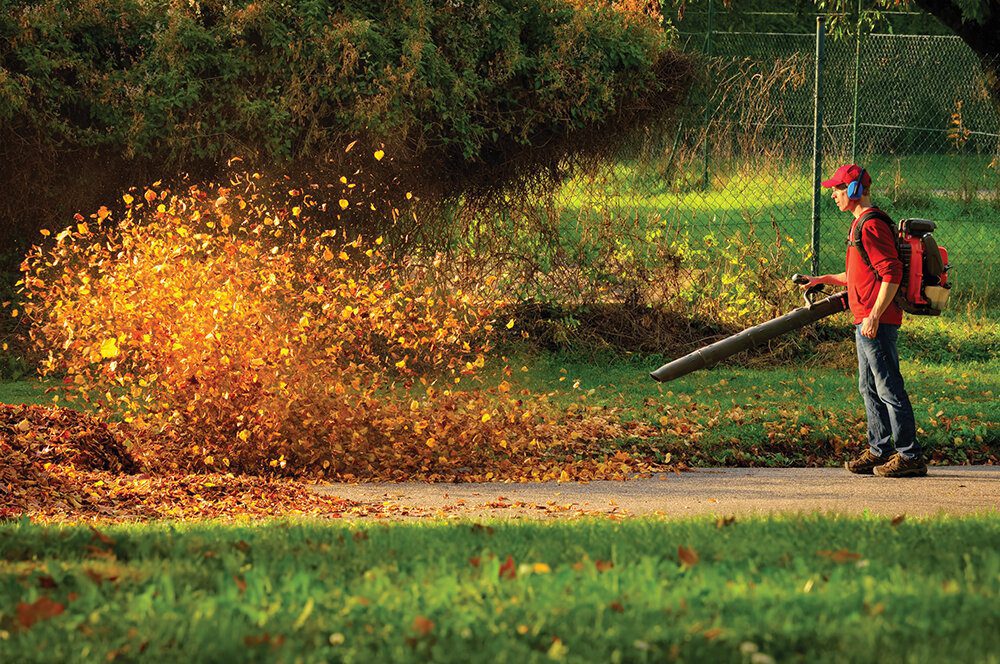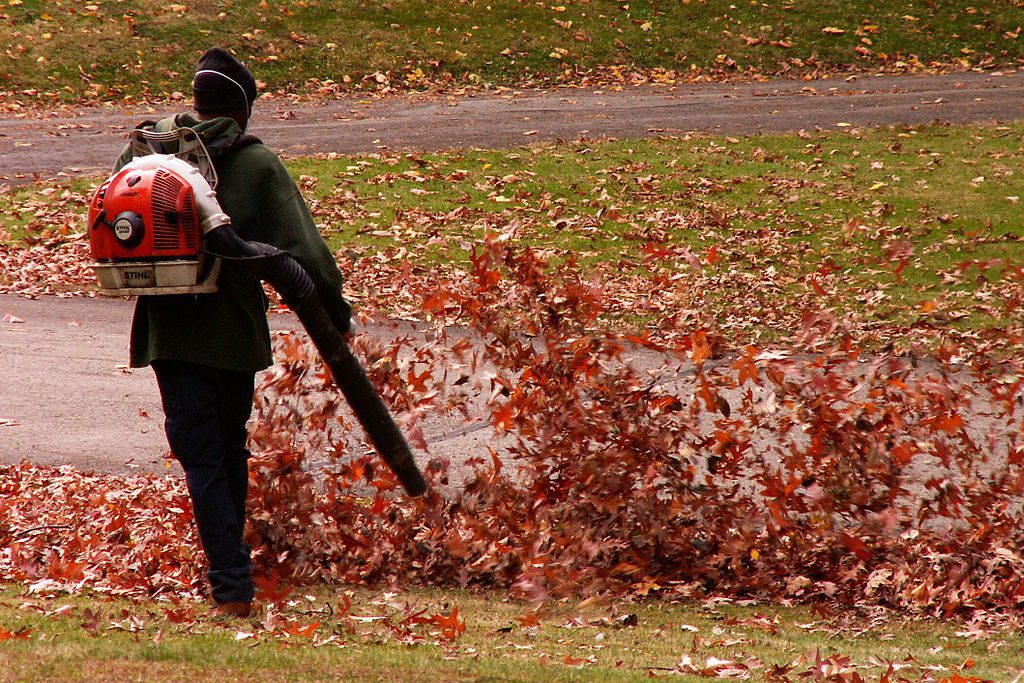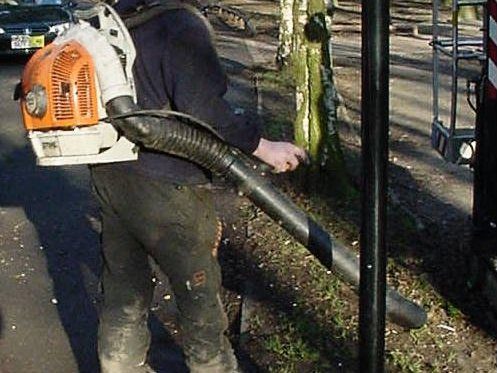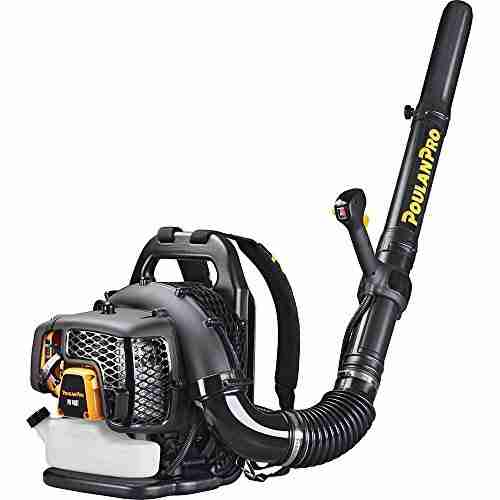If you’ve ever walked past a group of gardeners using leaf blowers, you’ve probably experienced the noisy disruption they create.
Leaf blowers have become a heated topic, with advocates arguing for their efficiency and opponents arguing against the noise and environmental impact.
This article explores the reasons behind the controversy surrounding leaf blowers, shedding light on the various perspectives and considerations involved.
Whether you’re a fan or a critic, understanding the issues can help inform your opinion on these powerful yet divisive tools.
Environmental Impact
Noise Pollution
Leaf blowers are known for their significant contribution to noise pollution. The loud and constant buzzing of leaf blowers can disrupt the peace and tranquility of residential areas and public spaces. Continuous exposure to such noise can cause annoyance, stress, and even harm hearing abilities. The whirring sound of leaf blowers can be particularly intrusive for those near where they are being used.
Air Pollution
Leafblowers can also contribute to air pollution. As they blast air at high speeds, they stir up dust, debris, and pollutants that may have settled on the ground. The fine particles and emissions leaf blowers release can be harmful when inhaled. They can aggravate respiratory conditions such as asthma and allergies and may even pose risks to the overall health of individuals exposed to the polluted air.
Greenhouse Gas Emissions
Another environmental concern associated with leaf blowers is their contribution to greenhouse gas emissions. Traditional gas-powered leaf blowers emit carbon dioxide (CO2) and other harmful gases contributing to climate change. The emissions from these machinery impact the immediate vicinity and add to the global challenge of reducing greenhouse gas emissions and combating the effects of climate change.
Disruption of Wildlife
The use of leaf blowers can disrupt the natural habitats of wildlife. The powerful gusts of air can displace small animals, birds, and insects, disturbing their nests and habitats. This disruption can have long-lasting effects on local ecosystems and biodiversity. Additionally, the noise generated by leaf blowers can scare away wildlife, disrupt their natural behaviors, and potentially lead to negative consequences for their survival and reproduction.
Health and Safety Concerns
Respiratory Problems
The dust, pollen, and other particles from leaf blowers can harm respiratory health. The fine particles emitted by leaf blowers can easily be inhaled, leading to potential respiratory problems. For individuals already suffering from respiratory conditions such as asthma or allergies, the pollutants released by leaf blowers can exacerbate their symptoms and make it harder for them to breathe.
Hearing Damage
The high decibel levels produced by leaf blowers can lead to hearing damage or impairment, especially with continued exposure. The prolonged use of leaf blowers without proper ear protection can result in permanent hearing loss or tinnitus for both the user and those nearby. Individuals operating leaf blowers must prioritize their hearing health and take precautions to prevent long-term damage.
Flying Debris
One of the safety concerns associated with leaf blowers is the potential for flying debris. As the powerful gusts of air blow leaves and other debris, they can result in projectiles that may cause injury to both the user and others nearby. Small rocks, sticks, or other objects can be propelled at high speeds, posing a significant risk to nearby individuals. Proper safety measures, such as wearing protective gear, are essential to minimize potential hazards.
Tripping Hazards
Leaf blowers often involve extension cords, creating tripping hazards if not properly managed. The long cords trailing behind the user can cause individuals to trip and fall, resulting in injuries. Practicing caution while operating leaf blowers is crucial, ensuring that cords are appropriately secured and out of the way to prevent accidents and minimize the risk of tripping.
Community Disturbance
Noise Complaints
The noise generated by leaf blowers often leads to an influx of noise complaints from residents and communities. The constant buzzing sound can be intrusive, particularly in residential areas where people value peace. Noise complaints highlight the annoyance caused by leaf blowers and indicate the potential negative impact on a community’s overall quality of life.
Negative Impact on Quality of Life
Leafblowers can hurt the quality of life within a community. The constant noise pollution and the air and environmental concerns associated with leaf blowers can affect the overall well-being of individuals in the vicinity. Enjoying peaceful outdoor activities, such as reading, gardening, or spending time with loved ones, may become challenging due to the disruptive nature of leaf blowers.
Interruption of Activities
Using leaf blowers can interrupt various activities in residential and public spaces. For instance, individuals may find it difficult to concentrate on work or studies due to the noise generated by leaf blowers. Furthermore, outdoor events and recreational activities may need to be postponed or relocated to minimize the interference caused by leaf blowers. The disruption of activities can create inconvenience and frustration for those living or working in areas where leaf blowers are extensively used.
Inefficiency and Ineffectiveness
Blowing Debris Rather Than Collecting
One of the criticisms of leaf blowers is their tendency to blow debris rather than effectively collect it. While the primary purpose of leaf blowers is to remove leaves and other debris from an area, the strong gusts of air often scatter the debris, making it challenging to contain and gather. This can result in a repetitive and inefficient process where the same debris is blown around multiple times without being effectively cleared.
Leaves and Dust Settle Back Quickly
Despite the efforts of leaf blowers, leaves, and dust can settle back quickly onto surfaces, making it seem like the cleaning process is ineffective. When the blowing ceases, the settled debris can be easily blown back or redistributed by natural elements like wind. This recurring cycle of blowing and settling can be frustrating and create a sense of futility in the cleaning process.
Limited Effectiveness on Wet Surfaces
Leaf blowers are generally less effective on wet surfaces. The moisture and weight of wet leaves make them harder to move or collect using traditional leaf blowers. In such scenarios, using leaf blowers may prove inefficient, requiring alternative methods such as raking or manual sweeping. The limited effectiveness of leaf blowers on wet surfaces may hinder their practicality, especially during rainy seasons or in regions with high humidity.
Potential Damage to Landscaping
The powerful airflow generated by leaf blowers has the potential to cause damage to delicate landscaping features. Flowers, small plants, and delicate mulch can be disrupted or even uprooted by the strong blasts of air. Additionally, loose topsoil may be blown away, leading to soil erosion and degradation. The potential damage to landscaping can outweigh the benefits of using leaf blowers, depending on the specific needs and requirements of the cleaned area.
Subset of Leaf Blower Users
Professional Landscapers
Professional landscapers often utilize leaf blowers as part of their regular maintenance routines. The speed and efficiency of leaf blowers make them a valuable tool in managing large areas with extensive leaf and debris coverage. However, professional landscapers must consider leaf blowers’ environmental impact and health concerns. Opting for quieter and more eco-friendly leaf blower models can help mitigate these issues and demonstrate responsible landscaping practices.
Homeowners and Gardeners
Homeowners and gardeners commonly use leaf blowers to maintain their yards and gardens. Whether it’s removing fallen leaves, grass clippings, or other debris, leaf blowers offer convenience and efficiency.
However, homeowners and gardeners need to consider the impacts of their leaf blower usage on the environment, their health, and the well-being of their neighbors. Exploring alternative solutions, such as manual raking or electric leaf blowers, can help balance cleanliness and sustainability.
Municipalities and Institutions
Municipalities and institutions, such as parks, schools, and universities, often rely on leaf blowers for large-scale outdoor maintenance. The vast expanse and diverse surfaces of public spaces make leaf blowers an attractive choice for quick and efficient cleaning.
However, these entities must also consider the potential disruptions caused by leaf blowers within the community. Implementing regulations, restrictions, and training programs for employees can help minimize the negative impacts of leaf blowers while still maintaining cleanliness.
Alternative Solutions
Raking and Manual Sweeping
Raking and manual sweeping are traditional methods of cleaning that offer several advantages compared to leaf blowers. These methods are quiet, do not produce emissions, and provide physical exercise for the individual performing the task. Raking and manual sweeping also enable more precise control over the movement and collection of debris, making them particularly effective on wet surfaces or delicate landscaping features. While these methods may require more effort and time, they are eco-friendly and contribute to a healthier and quieter environment.
Using Electric Leaf Blowers
Electric leaf blowers offer a more environmentally friendly alternative to traditional gas-powered models. Electric leaf blowers do not emit harmful gases; their decibel levels are generally significantly lower than gas-powered ones. Electric leaf blowers are usually lighter, making them easier to handle and maneuver. While electric leaf blowers are dependent on a power source and may have limited battery life, they can still provide efficient cleaning options for smaller residential areas or where power outlets are accessible.
Implementing Regulations and Restrictions
Implementing regulations and restrictions can help address the issues associated with leaf blowers. Local governments can enforce restrictions on the hours of use, require the use of quieter models, or even ban gas-powered leaf blowers altogether.
By setting regulations and guidelines, communities can strike a balance between maintaining cleanliness and reducing the negative impacts of leaf blowers. Creating awareness campaigns and providing educational resources can also help promote responsible leaf blower usage.
Public Opinion and Grassroots Movements
Arguments in Favor of Leaf Blower Bans
There is a growing public sentiment in favor of banning or heavily restricting leaf blowers. Many argue that leaf blowers disrupt the peace of neighborhoods, interfere with outdoor activities, and contribute to pollution and health hazards.
Those in favor of bans also emphasize the inefficiency of leaf blowers, citing the blowing and settling cycle and the potential damage to landscaping. Supporters of bans advocate for more sustainable and quieter alternatives, such as manual leaf removal methods.
Arguments Against Leaf Blower Bans
On the other hand, there are arguments against banning leaf blowers altogether. These individuals highlight leaf blowers’ convenience and time-saving benefits, particularly for professionals and those with more significant properties.
Some argue that technological advancements, such as quieter and more efficient leaf blowers, are already addressing the concerns and mitigating the negative impacts of leaf blowers. Additionally, proponents of leaf blowers suggest that education and responsible usage can help minimize the environmental and health concerns associated with their use.
Role of Social Media and Activism
Social media platforms and grassroots movements have significantly raised awareness about the controversies surrounding leaf blowers. Online communities and activism campaigns have given individuals a platform to voice their concerns and opinions, often leading to localized discussions and policy changes.
Through targeted campaigns, social media users and activists have successfully advocated for restrictions or bans on leaf blowers in specific regions or communities, sparking more extensive conversations about the environmental impact and health issues associated with their use.
Economic and Practical Considerations
Cost of Equipment and Maintenance
The cost of leaf blowers, in terms of their initial purchase and ongoing maintenance, can vary significantly. Gas-powered leaf blowers are relatively more expensive than their electric counterparts. Additionally, gas-powered leaf blowers require fuel and regular maintenance, adding to the overall cost. On the other hand, electric leaf blowers have a lower upfront cost and usually require less maintenance. Homeowners, professional landscapers, and institutions must consider the initial investment and the long-term expenses when choosing the appropriate equipment.
Efficiency and Time Savings
One of the primary reasons why leaf blowers are favored is their efficiency and time-saving capabilities. Unlike manual leaf removal methods, leaf blowers allow quicker and more thorough cleaning, especially in larger areas. This efficiency can be particularly valuable for professional landscapers and municipalities that must maintain vast spaces within limited time constraints. However, evaluating the trade-offs between efficiency and the potential negative impacts associated with leaf blower usage is essential.
Availability of Labor
The availability of labor is another practical consideration when it comes to the use of leaf blowers. In areas where manual labor is scarce or expensive, leaf blowers can be a viable solution for effective leaf removal.
The ease of use and the relatively minimal physical effort required make leaf blowers attractive for those who may not have access to sufficient workforce or resources. However, balancing this convenience with considerations of environmental impact and community disturbances is crucial.
Benefits for Some Industries
Specific industries like landscaping and property maintenance rely heavily on leaf blowers. For professional landscapers, leaf blowers provide an efficient and time-saving solution to maintain clients’ properties and meet their expectations.
The ability to quickly remove leaves and debris can enhance the overall aesthetic appeal of landscapes and contribute to customer satisfaction. However, these industries must explore more sustainable practices and consider their operations’ broader environmental and health implications.
Local Legislation and Policies
Leaf Blower Bans and Restrictions
Several cities and municipalities worldwide have implemented various bans and regulations on leaf blowers. These regulations can include restrictions on the hours of use, noise levels, types of leaf blowers allowed, or, in some cases, complete bans on gas-powered leaf blowers.
The specifics of these bans and restrictions vary depending on local legislation and public sentiment. By implementing such policies, communities aim to strike a balance between maintaining cleanliness and ensuring the well-being of their residents.
Noise Regulations
Noise regulations play a crucial role in managing the impact of leaf blowers on communities. Local governments often set specific decibel limits to control the noise generated by leaf blowers.
By enforcing noise regulations, authorities aim to reduce noise pollution and protect the overall quality of life within residential areas. However, these regulations must be regularly reviewed and updated for technological advancements and evolving community needs.
Seasonal Limitations
Seasonal limitations on leaf blower usage are another approach taken by some communities. These limitations may be imposed when leaf fall is heaviest, usually in the fall or autumn seasons. By restricting leaf blower usage to specific periods and encouraging alternative methods during the rest of the year, communities can address the concerns associated with leaf blowers while allowing for their practical use when needed.
Enforcement Challenges
Enforcing regulations and restrictions on leaf blowers can challenge local authorities. Monitoring and ensuring compliance can be difficult, particularly in larger communities or areas with limited resources. The cooperation of residents, professional landscapers, and other stakeholders is crucial for effective enforcement. Education and awareness campaigns can help inform individuals about the regulations in place and foster a sense of responsibility and cooperation.
Emerging Technologies and Innovations
Quieter and More Efficient Leaf Blowers
Technological advancements have led to the development of quieter and more efficient leaf blowers. Manufacturers have been working on reducing the noise levels produced by leaf blowers, making them less disruptive for users and surrounding communities. Quieter leaf blowers help address the concerns of noise pollution while still providing efficient leaf removal. These advancements in acoustic engineering contribute to a more harmonious coexistence of leaf blowers and the environment.
Battery-Powered and Electric Models
Battery-powered and electric leaf blowers offer a greener alternative to gas-powered models. These models eliminate the need for gasoline and reduce greenhouse gas emissions associated with leaf blower usage. Electric leaf blowers generally produce lower noise levels, creating a quieter and more peaceful outdoor environment. The advancements in battery technology have also resulted in longer-lasting battery life, enhancing the practicality of electric leaf blowers for extended use.
Robotic and Autonomous Leaf Cleaners
The development of robotic and autonomous leaf cleaners presents an innovative solution to leaf removal. These devices utilize artificial intelligence and advanced sensors to autonomously navigate outdoor spaces, detecting and clearing leaves and debris.
Robotic leaf cleaners can operate quietly and efficiently with minimal human intervention. While these technologies are still evolving and may have limitations, they show great potential in revolutionizing leaf removal practices, reducing noise pollution, and promoting sustainable outdoor maintenance.
In conclusion, leaf blowers are controversial due to their environmental impact, health and safety concerns, community disturbances, inefficiency, and effectiveness.
The subset of leaf blower users includes professional landscapers, homeowners, gardeners, and municipalities/institutions. Alternative solutions like raking and manual sweeping, using electric leaf blowers, and implementing regulations and restrictions offer sustainable and quieter options. Public opinion and grassroots movements surrounding leaf blowers have gained momentum, with arguments favoring and against bans. Economic and practical considerations and local legislation and policies are crucial in determining leaf blowers’ acceptability and responsible use.
Finally, emerging technologies and innovations, including quieter models, battery-powered leaf blowers, and robotic leaf cleaners, pave the way for more environmentally friendly and efficient leaf removal practices.

